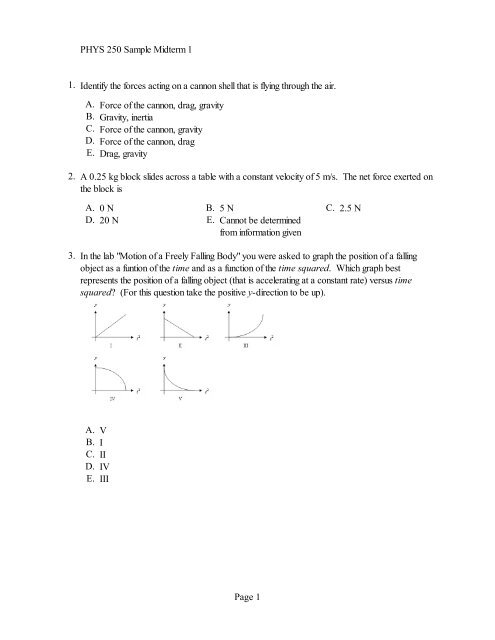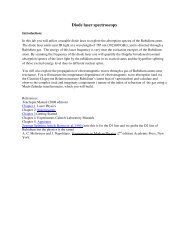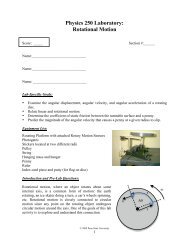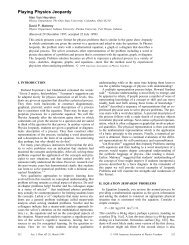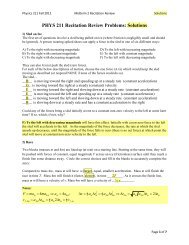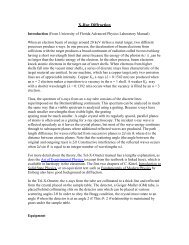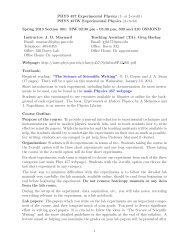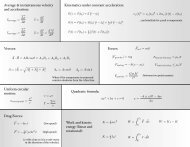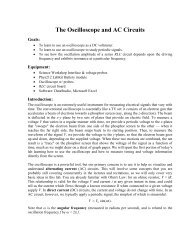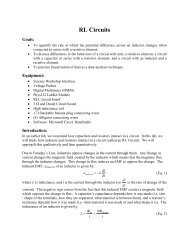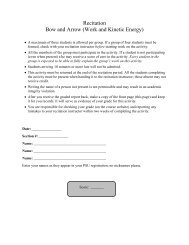You also want an ePaper? Increase the reach of your titles
YUMPU automatically turns print PDFs into web optimized ePapers that Google loves.
PHYS 250 <strong>Sample</strong> <strong>Midterm</strong> 1<br />
1. Identify the forces acting on a cannon shell that is flying through the air.<br />
A. Force of the cannon, drag, gravity<br />
B. Gravity, inertia<br />
C. Force of the cannon, gravity<br />
D. Force of the cannon, drag<br />
E. Drag, gravity<br />
2. A 0.25 kg block slides across a table with a constant velocity of 5 m/s. The net force exerted on<br />
the block is<br />
A. 0 N B. 5 N C. 2.5 N<br />
D. 20 N E. Cannot be determined<br />
from information given<br />
3. In the lab "Motion of a Freely Falling Body" you were asked to graph the position of a falling<br />
object as a funtion of the time and as a function of the time squared. Which graph best<br />
represents the position of a falling object (that is accelerating at a constant rate) versus time<br />
squared? (For this question take the positive y-direction to be up).<br />
A. V<br />
B. I<br />
C. II<br />
D. IV<br />
E. III<br />
Page 1
PHYS 250 <strong>Sample</strong> <strong>Midterm</strong> 1<br />
4. A 2-kg object is falling downward with its speed increasing at a rate of 8 m/s per second. We<br />
conjecture that there must be some other force acting on the object in addition to the downward<br />
pull of gravity. What can we say about this other force?<br />
A. It has a magnitude of 2 N and points in the downward direction.<br />
B. It has a magnitude of 16 N and points in the upward direction.<br />
C. It has a magnitude of 36 N and points in the upward direction.<br />
D. It has a magnitude of 4 N and points in the upward direction.<br />
E. It has a magnitude of 20 N and points in the downward direction.<br />
5. A force of 120 N is applied to an object whose mass is 30 kg. The object's acceleration is:<br />
A. 4.0 m/s 2 .<br />
B. 0.25 m/s 2 .<br />
C. 150 m/s 2 .<br />
D. 3600 m/s 2 .<br />
6. Abby throws a ball straight up and times it. She sees that the ball goes by the top of a flagpole<br />
after 0.60 s and returns to the level of the top of the pole after a total elapsed time of 4.20 s.<br />
What was the speed of the ball at launch?<br />
A. 33.9 m/s<br />
B. 11.3 m/s<br />
C. 23.5m/s<br />
D. 45.2 m/s<br />
7. A ball is thrown straight up into the air. At the highest point in its trajectory, the net force acting on<br />
it is:<br />
A. equal to its weight.<br />
B. less than its weight, but not zero newtons.<br />
C. 9.8 newtons.<br />
D. greater than its weight.<br />
E. zero newtons.<br />
Page 2
PHYS 250 <strong>Sample</strong> <strong>Midterm</strong> 1<br />
8.<br />
v <br />
i<br />
v <br />
f<br />
An airplane initially heading north makes a 90° turn east such that its<br />
speed remains constant. The plane’s velocity vector before and after<br />
the turn are shown at left. Which of the options below represent the<br />
plane’s change in velocity vector?<br />
A. B. C. D. E.<br />
9. Find the magnitude and direction of the net force on the object in each of the free-body diagrams<br />
in the figure below.<br />
A. (a) 30 N to the right; (b) 10 N to the right; (c) 18 N upward<br />
B. (a) 40 N to the left; (b) zero; (c) 18 N downward<br />
C. (a) 30 N to the right; (b) zero; (c) 18 N upward<br />
D. (a) 40 N to the left; (b) 10 N to the right; (c) 18 N downward<br />
E. (a) 30 N to the right; (b) zero; (c) 18 N downward<br />
10. Find the x- and y-components of a position vector, r , with a magnitude of r = 77 m and<br />
an angle with respect to the x-axis of 25°.<br />
A. (69.8 m, 32.5 m)<br />
B. (-10.2 m, 76.3 m)<br />
C. (69.8 m, -10.2 m)<br />
D. (76.3 m, -10.2 m)<br />
E. (32.5 m, 69.8 m)<br />
Page 3
PHYS 250 <strong>Sample</strong> <strong>Midterm</strong> 1<br />
11. A boy throws a ball at an initial velocity of 26 m/s at an angle of 20o above the horizontal. How<br />
high above the projection point is the ball after 1.4 s?<br />
A. 2.8 m<br />
B. 1.4 m<br />
C. 8.2 m<br />
D. 24 m<br />
E. 23 m<br />
12. You heave a baseball straight upwards such that it leaves your hand with a speed of 20 m/s<br />
(approximately 45 mph). If we neglect the effects of air resistance, approximately how long does<br />
it take the baseball to return to your hand?<br />
A. 4 s<br />
B. 3 s<br />
C. 5 s<br />
D. 1 s<br />
E. 2 s<br />
13. A bullet is fired from ground level with a speed of 250 m/s at an angle 35o above the horizontal at<br />
a location where g = 10.0 m/s 2 . How long does it take before the bullet hits the ground?<br />
A. 41.0 s<br />
B. 28.7 s<br />
C. 20.5 s<br />
D. 14.3 s<br />
E. 1 35.0<br />
Page 4
PHYS 250 <strong>Sample</strong> <strong>Midterm</strong> 1<br />
14. In a game of three-way tug-of-war, Team Agathon and Team Boomer each pull as shown in the<br />
free-body diagram below. Determine the appropriate components of the force exerted by the<br />
third team, Team Caprica, if there is to be a tie (i.e., no team successfully moves the knot in the<br />
middle.) Each grid unit represents one newton.<br />
y<br />
F <br />
Agathon<br />
F <br />
Boomer<br />
x<br />
<br />
F x yˆ<br />
A.<br />
Caprica<br />
7N ˆ<br />
2N<br />
B. <br />
Caprica<br />
3N ˆ<br />
1N <br />
C. <br />
Caprica<br />
2N ˆ<br />
7N <br />
D.<br />
<br />
FCaprica<br />
9Nxˆ<br />
E.<br />
<br />
Caprica<br />
7N ˆ2N<br />
F x yˆ<br />
F x yˆ<br />
F x yˆ<br />
15.<br />
<br />
v constant<br />
<br />
m<br />
T <br />
A heavy block with a mass m is<br />
being pulled up a smooth,<br />
frictionless incline by a rope such<br />
that the block moves up the ramp<br />
at a constant velocity. What must<br />
the tension in the rope be?<br />
A. mg tan<br />
B. mg sin<br />
C. mg<br />
D. mg cos<br />
E. It depends upon how fast the block is being pulled.<br />
Page 5
PHYS 250 <strong>Sample</strong> <strong>Midterm</strong> 1<br />
16. A 20-ton truck collides with a 1500-lb car and causes a lot of damage to the car. We can<br />
definitely say that:<br />
A. The force exerted on the truck (by the car) is less than the force exerted on the car (by the<br />
truck).<br />
B. The force exerted on the truck (by the car) is equal to the force exerted on the car (by the<br />
truck).<br />
C. The truck did not slow down during the collision.<br />
D. The force exerted on the truck (by the car) is greater than the force exerted on the car (by<br />
the truck).<br />
E. The car did not slow down during the collision.<br />
17. A 0.5-kg glider floats at rest on a cushion of air above an air track. (The glider/track system is<br />
essentially frictionless.) Lauren pulls a string connected to the right side of the glider with a<br />
constant force of 10 N. Simultaneously, Paula pulls a string connected to the left side of the glider<br />
with a constant force of 6 N. What happens to the glider?<br />
A. It moves to the right, speeding up at a constant rate of 32 m/s per second.<br />
B. It moves to the right, slowing down at a constant rate of 12 m/s per second.<br />
C. It moves to the right, speeding up at a constant rate of 20 m/s per second.<br />
D. It moves to the right, speeding up at a constant rate of 8 m/s per second.<br />
E. It does not move at all.<br />
Page 6
PHYS 250 <strong>Sample</strong> <strong>Midterm</strong> 1<br />
18. A 1-kg block rests on a horizontal, frictionless table and is fastened to a spring of negligible mass,<br />
which is mounted to the wall. The spring has a spring constant of 600 N/m. The block is pushed 3<br />
cm toward the wall (thus compressing the spring) and then released.<br />
1 kg<br />
(system at rest)<br />
1 kg<br />
(spring compressed )<br />
Which of the following show a correct free-body diagram for the block at the instant just after it is<br />
released?<br />
A.<br />
N B.<br />
table on block<br />
N C.<br />
table on block<br />
N table on block<br />
f table on block F <br />
spring on block<br />
W earth on block<br />
F <br />
W spring on block<br />
earth on block<br />
F block on spring F <br />
spring on block<br />
W earth on block<br />
D.<br />
N E.<br />
table on block<br />
F block on spring<br />
N table on block<br />
F block on spring F <br />
spring on block<br />
W earth on block<br />
W earth on block<br />
Page 7
PHYS 250 <strong>Sample</strong> <strong>Midterm</strong> 1<br />
19. The position versus time graph below represents the motion of an object moving in a straight line.<br />
12<br />
position (centimeters)<br />
10<br />
8<br />
6<br />
4<br />
2<br />
0<br />
2<br />
4<br />
1 2 3 4 5 6<br />
time (seconds)<br />
7 8<br />
What is the object's instantaneous velocity at t = 3.0 s?<br />
A. 4.00 cm/s<br />
B. 0.00 cm/s<br />
C. 8.00 cm/s<br />
D. 3.00 cm/s<br />
E. 1.33 cm/s<br />
20. An object moves, pulling a paper tape through a ticker timer which records a dot on the paper at<br />
regular time intervals. What can you determine from the object's motion based on the following<br />
ticker tape? (To aid in making your determination, the paper tape has regularly spaced ruled<br />
marks printed on it as well.)<br />
A. The object had a constant acceleration for the duration of the recording.<br />
B. The object had a constant position for the duration of the recording.<br />
C. The object had a constant velocity for the duration of the recording.<br />
D. The object moved the same distance during each time interval recorded.<br />
E. None of the above statements are true.<br />
Page 8


